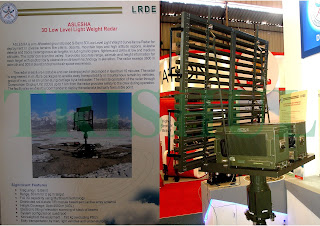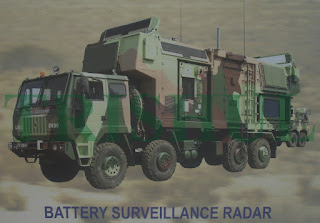ADTCR of Indian Army’s ADC & RS
The ADTCR is the Army version of the Indian Air Force’s (IAF) gapfiller
Ashwini LLTR.
Based on the DRDO’s proposal
in January 2009, the MoD sanctioned the DRDO’s efforts to engage 13 Indian
industrial partners for developing an active phased-array, S-band LLTR known as
Ashwini. The IAF has indicated an initial order for 18 Ashwini LLTRs, following
successful field evaluation trials (FET), against a total requirement for 67.
Low-Level
Transportable Radars (LLTR) are required for surveillance against low-level
intrusion of airspace up to a height of 30 metres in a range of 150km. In 1997
the Indian Air Force (IAF) HQ had projected a requirement of active
phased-array LLTRs and in January 1998 had obtained ‘in-principle’ approval
from the Ministry of Defence (MoD) for the acquisition of 37 LLTRs. IAF HQ’s
efforts to import LLTRs on four occasions (between March 1998 and February
2002) did not fructify due to the MoD-owned Defence Research & Development
Organisation’s (DRDO) objections on the issue of the quantum of transfer of
technology (ToT) from foreign vendors. However, for meeting the immediate
requirements, the Defence Acquisition Council (DAC) in October 2005 accorded
‘Acceptance of Necessity’ (AoN) to import 19 GS-100 LLTRs from THALES of France
under the ‘Buy & Make’ category along with associated industrial ToT, with
the balance of 18 LLTRs to be developed by the DRDO’s Electronics R & D
establishment (LRDE) under the ‘Make’category. The MoD inked two contracts in
July 2009 for the procurement of 19 GS-100 LLTRs at a total cost of Rs.1,272
crore. The ‘Buy’ part of ‘Buy and Make’ contract was concluded with THALES for
the procurement of six fully-furnished (FF) LLTRs along with communications and
associated equipment; and knocked-down kits for 13 GS-100s along with
industrial ToT at a total cost of Rs.572.20 crore, with the delivery schedule
lasting from February 2012 till March 2013 (later revised to June 2015).
Advance payment of Rs.85.82 crore was also released to THALES in November 2009.
The ‘Make’ part of ‘Buy and Make’ contract was concluded with the MoD-owned
Bharat Electronics Ltd’s (BEL) Ghaziabad facility at a cost of Rs.699.54 crore
for the licenced-assembly and supply of the 13 GS-100s between March 2013 and
March 2015. An advance of Rs..160.97 crore was also paid to BEL in November
2009. However, it was only by late 2017 that all the GS-100s had been delivered
to the IAF.
The Ashwini LLTR is in turn networked with the IAF’s Arudhra MPR through the IACCCS system.
Based
on the Indian Air Force’s ASQR of August 2003 for an air base-located 3-D,
S-band Central Acquisition Radars (CAR), the MoD in November 2003 sanctioned a
Mission Mode project of the LRDE called ‘Rohini’ at a cost of Rs.34.05 crore
with a PDC of 36 months (by November 2006). Subsequently,
the LRDE inked a comprehensive technology transfer-cum-IPR rights buyout
package with Poland’s Przemyslowly Instytut Telekominikacji SA under which
the DRDO would obtain and transfer the production technology for the
PIT-developed TRS-17 S-band, 3-D radar with 240km range, to BEL.
However, the project sanction did not include the post-development activities
such as user-trials and its acceptance by the IAF. By August 2007 the LRDE had
developed the radar within the extended PDC (August 2007) with an expenditure
of Rs.28.02 crore and the project was closed in August 2007.
The IAF carried
out the 3-D CAR’s trials between February 2008 and March 2008 and recommended
its induction into service. The project was completed by December 2010 with an
extra expenditure of Rs.7.27 crore. During the course of development and trials
of the ‘Rohini’, the IAF had placed two supply orders (in March 2006 and July
2009, respectively) with BEL for the manufacture and supply of 37 ‘Rohini’ 3-D
CARs, while the Army has since ordered 14.
Low-Level
Lightweight Radars (LLLWR) with a range of 50km that can be transported by
animal carts/trucks/helicopters for deployment in difficult and high-altitude
terrain. Based on the IAF’s August 2004 requirement for 36 LLLWRs and the DAC’s
‘in-principle’ approval in September 2004 for procuring 15 ELTA-supplied EL/M-2026B
X-band LLLWRs through the ‘Buy’ option, with the balance 21 being acquired
through indigenous development by the LRDE, the MoD in December 2004 sanctioned
the development of the S-band ‘Aslesha’ LLLWR under Mission Mode at a cost of
Rs.21.94 crore with a PDC of 30 months (June 2007). After user-trials were
conducted between December 2009 and February 2010, the IAF in February 2010
recommended improvements in the power supply system, sensor head and the
Commander’s Display Unit. The LRDE agreed to carry out the changes in
production models and in September 2011 closed the project as successful with
an expenditure of Rs.20.77 crore. Deliveries of these LLLWRs was delayed by 23
months and were completed in June 2015.
A proposal for
procurement of 38 ‘Bharani Mk.2’ 3-D LLLWRs for the Indian Army under the ‘Buy
Indian’ category based on a design from the LRDE was forwarded by the MoD in
July 2012 to BEL for comments. The proposal was sent considering that the LRDE
had already developed the L-band Bharani Mk.1 LLLWR, which was then under
series-production by BEL (16 units) under a contract signed in March 2011.
While the Mk.1 radar was 2-D/L band radar, the proposed Bharani Mk.2 was
envisaged as a 3-D surveillance radar with better low-altitude target detection
capability and improved operational and performance characteristics. In April
2013 the Board of Directors of BEL approved a proposal to develop one prototype
of Bharani Mk.2 having features similar to thye IAF’s S-band Aslesha LLLWR at
an estimated cost of Rs.17.36 crore, including a capital investment and offer
it for evaluations and field demonstrations to the Indian Army within a
timeframe of 18 months. The Board also advised BEL’s Management to sign a
detailed Memorandum ofUnderstanding (MoU) with the LRDE since the latter would
be the systems design agency for Bharani Mk.2. As per the timeline fixed by the
Board, the Probable Date of Completion of design and development was October
2014. However, progress in the project was delayed due to finalisation of the
design by the LRDE and subsequently conducting the Preliminary Design Review
with the end-user and BEL.
Meanwhile, the LRDE in September 2014 informed BEL
that during the Quarterly Interactive Meeting with Army Air Defence
Directorate, the end-user showed keenness on S-Band and an Aslesha radar
modified for meeting the Bharani Mk.2 requirements was to be fielded for user
evaluations by March 2015. Due to change of the operating band, development of
the L-band Bharani Mk.2 was kept on hold till November 2014, and a fresh
sanction was accorded in March 2015 by the Chairman and Managing Director of BEL
for the development of an S-band Bharani Mk.2 at an estimated cost of Rs.4.98
crore. An expenditure to the tune of Rs.11.45 crore was incurred on the
development of the L-band Bharani Mk.2 till March 2016. As the development was
put on hold, most of the above expenditure was rendered futile. Also, BEL did
not adhere to the directions of the Board to sign a MoU with LRDE to ensure
clarity to the project and commitment from LRDE. BEL’s Management stated in
September 2016 that the LRDE being the designated design agency, had proposed
Bharani Mk.2 using semi-active phased-array technology in L-band. The change in
frequency band necessitated design changes. Out of the total expenditure of
Rs.11.45 crore, most of the money was utilised in new
development/modification/realisation of the S-band version based on Aslesha.
The DRDO, along with private
sector Indian industry, has also developed upgrade packages for the existing 30
Indra-1 (GRL-600) 2-D L-band gapfiller radars of the IAF and seven Indra-2
(GRL-610) of the Indian Army, which were supplied by Bharat Electronics Ltd
(BEL) in the 1980s. All these radars can now function as 3-D solid-state
digital radars. A similar upgrade package is now available for the IAF’s 18
PSM-33 Mk.2 L-band 3-D high-power radars (HPR) of late-1970s vintage.
Meanwhile, BEL with the assistance of THALES has refurbished the nine
THALES-supplied TRS-2215D S-band HPRs that had been procured since February
1984. The DRDO has already commenced work on developing an indigenously
designed L-band HPR, for which a requirement of 15 units has been identified by
the IAF.
In November 2002 the IAF had projected a requirement of 23 S-band active phased-array medium-power radars (MPR) for service-induction between 2007 and 2017, so that they could replace the BEL-built L-band PSM-33 Mk.1/2, P-40 and TRS-2215D radars, which had completed their service life of 29 years. Based on the IAF HQ’s ASQR of November 2004 and due to non-availability of indigenous technologies, the MoD in April 2006 approved the importing of 15 MPRs (ELTA Systems’ EL/M-2084) and the indigenous development of eight ‘Arudhra’ MPRs. FET of the Arudhra was completed in October 2018 with success. In addition, 37 ‘Rohini’ air base-located 3-D, S-band Central Acquisition Radars (CAR) have been delivered as were 21 DRDO-developed ‘Aslesha’ S-band low-level lightweight radars (LLLWR).
For ensuring
gap-free air-surveillance along the mountain valleys and high-altitude passes
in India’s north-west, northern and north-east regions, a total of 10 ELTA Systems-built L-band EL/M-2083 ‘Airstar’
aerostat-mounted MPRs is required to add to the two already in service, as are 15
L-band active phased-array high-power airspace surveillance radars. These new
radars will be interfaced with the IAF’s existing 32 new mobile control and
reporting centres (MCRC), 12 air defence control centres (ADCC), 24 air defence
direction centres (ADDC) and some 40 terminal weapons control centres (TWCC) along
India’s western and north-eastern borders, The 1,700kg EL/M-2083 ‘Airstar’ is
mounted inside 240 feet-long aerostat that is perched at altitudes of up to
4,000 feet, use electronically-steered multi-beam techniques to detect terrain
hugging airborne targets—combat aircraft, helicopters, cruise missiles and
UAVs—at ranges of up to 300km, while the trajectories of ballistic missiles can
be accurately plotted up to 500km away.
ASAT Missile
Short-Span Bridging System
Upgunning Elements of OFB-Built 8.4-Tonne Sharang 155mm/45-Cal Towed Howitzer
Air-Defence Systems To Be Displayed At Future RDPs



















































